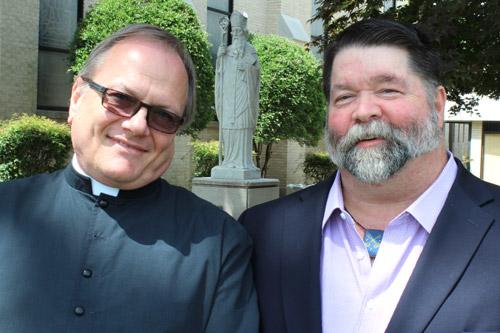
Faith is a beam of light, but run through the prism of culture, even a Catholic population as small as Arkansas’ can cast many colors. Just within central Arkansas, the inquisitive parishioner can experience liturgies and music in Spanish, Korean and Igbo Nigerian and see architecture and festivals that reflect Italian, Polish, German and other influences.
St. John the Baptist Latin Mass Community, based at St. Patrick Church in North Little Rock, shares a spot on this roster, but with one exceptional quality. While other cultural variances reflect the Church’s particular place in the world, the Latin Mass represents the doctrinal heritage that brought the world into the Church. And, says Father Michael Magiera, FSSP, it’s attracting a growing number of worshipers.
“We have Mass every day, twice on Sunday,” he said. “On a typical Sunday, I would say we have about 150. They’re pretty consistent and they travel from great distances, some of them very great distances. The Mass means enough to them that they are willing to inconvenience themselves to come here.”
Technically speaking, Masses are celebrated using the Tridentine, or Extraordinary Form of the Roman Rite. Run of the mill in the pre-Vatican II era, it’s a liturgy the vast majority of Catholics under 50 have never heard before. While acknowledging language and navigating the missal are common barriers, parishioner and father of six Earnie Cavin said the beauty of the liturgy trumps those problems for many people.
“The first time I took my family to a Latin Mass, I was sold, immediately,” he said. “This is what I remember when I was a very small child, but it wasn’t nostalgia. The prayers were very focused and the liturgy was just so rich.”
Cavin said while it took a little time for the rest of his family to share his enthusiasm, today it’s important enough for his wife to attend daily Mass in addition to the family’s weekly worship, despite having to drive more than an hour to get here.
Of course, it’s not just the vernacular; there are other distinct differences between the Latin Mass and the “novus ordo” or “new order of the ages.” The most striking of these is how celebrant and congregation face the same direction — east —therefore putting the priest’s back to the people.
Other things the newcomer notices right away are the incense and chanting employed every Sunday at the 11 a.m. Mass, women and girls covering their heads and the absence of many of the now-familar roles for laypersons, like distributing the Eucharist and proclaiming the readings.
All of this is old hat to anyone who came of age before Vatican II, but the Latin Mass isn’t simply a reliquary of the Church’s old guard. Father Magiera said as the generation that ushered in the era of reform, many older Catholics adopted the “new Mass” and didn’t look back. Today, younger Catholics with families dominate the congregation.
“It’s all the young, which amazes people,” Father Magiera said. “It’s funny, (people) come in with assumptions that (Latin Mass) is something that’s from so long ago that it’s only going to be old people. That’s never, ever, ever the case.”
“It’s not necessarily just the form of the Mass, it’s the gestalt,” he said. “The Mass is just one of the manifestations of it. It’s the entirety of it. It is something that is a very firm foundation, it’s black and white, it’s simple. You don’t have the ambiguity."
Cavin agreed, saying one important benefit this simplicity afforded him was setting a chartable course for everyday life. A fifth-generation member of St. Patrick Church, he’s attended both forms of the Mass but feels more directly a set of moral marching orders from the Latin rites.
“Guys, we like to hear what we need to do, give it to us and let us go to work,” he said with a chuckle. “This is more nutsy-boltsy, not as touchy-feely.”
Please read our Comments Policy before posting.
Article comments powered by Disqus Studio 3:16 offers new approach to teaching religion
Studio 3:16 offers new approach to teaching religion
 After three decades, NLR principal plans to retire
After three decades, NLR principal plans to retire
 CHS athlete overcomes odds to reach collegiate goal
CHS athlete overcomes odds to reach collegiate goal
 John Calipari: UA basketball coach and devout Catholic
John Calipari: UA basketball coach and devout Catholic
 'Cabrini' film tells story of saint with great faith
'Cabrini' film tells story of saint with great faith
 St. Joseph a model of solidarity with immigrants
St. Joseph a model of solidarity with immigrants
 Two gifts after Jesus’ death: Virgin Mary and Eucharist
Two gifts after Jesus’ death: Virgin Mary and Eucharist
 Why we have an altar, and not just a communion table
Why we have an altar, and not just a communion table
 Pope: Wars should be resolved through nonviolence
Pope: Wars should be resolved through nonviolence
 Living relationship with Jesus Christ in the Eucharist
Living relationship with Jesus Christ in the Eucharist